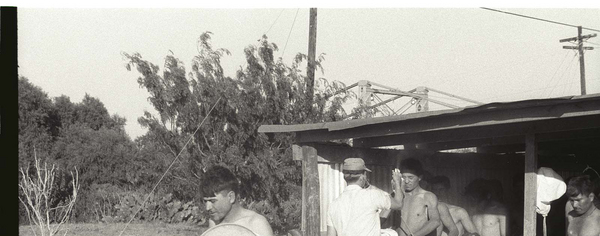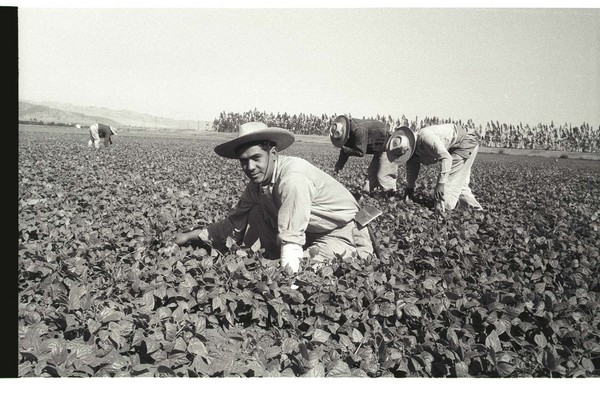The words “Mexican immigration” are usually enough to start a vibrant, politically and emotionally charged debate. Yet, the history of Mexican migration to the U.S. involves a series of ups and downs—some Mexicans were granted citizenship by treaty after their lands were annexed to the U.S., and, until the 1970s, they were considered legally white—a privilege granted to no other group. At the same time, Mexicans crossing the border every day were subjected to invasive delousing procedures, and on at least two occasions were subjected to incentivized repatriation.
Guest Miguel A. Levario from Texas Tech University (and a graduate of UT’s Department of History!) walks us through the “schizophrenic” relationship between the US and its southern neighbor and helps us ponder whether there are any new ideas to be had in the century long debate it has inspired—or any easy answers.
Guests
 Miguel A. LevarioAssociate Professor of History at Texas Tech University
Miguel A. LevarioAssociate Professor of History at Texas Tech University
Hosts
 Christopher RosePostdoctoral Fellow, Institute for Historical Studies, The University of Texas at Austin
Christopher RosePostdoctoral Fellow, Institute for Historical Studies, The University of Texas at Austin
Where do we want to start the story of Mexican migration to the U.S.?
Well, as an historian would do, we can go back as far as we can–all the way to the colonial period, but I think for the sake of our conversation we should start with the Treaty of Guadalupe in 1848, where the understanding of citizenship and even to a small degree immigration flow to what became the United States–which is the southwestern part, that was formerly northern Mexico. But, essentially in the modern context, how we understand Mexican migration, it really begins in 1910 with the Mexican Revolution.
The Revolution, which lasted between 1910 and 1920, spurred the first major migration from Mexico. We have estimated approximately one million people coming into the United States from Mexico during that period. Of course, we have to take that number with a grain of salt because we can’t document everybody, but with the crisis and the chaos and the economic upheaval with the war, people were displaced. We can also understand that the United States was very much in an industrial revolution at the time, and was clamoring for labor from all parts of the world, including Mexico. So, there was also that pull factor during the 1910s.
Ironically, what’s interesting about that period is that it’s also the era of some of the most restrictive immigration policies in American history. Probably the most infamous one is the Chinese Exclusion Act of 1882 that lasted until 1943, but we see a series of policies passed in the 1910s, most notably in 1917, which was one of the most comprehensive immigration restrictive laws we’ve ever had. The United States not only barred immigration from what they called the Asiatic bar zone, but they also identified types of people that were going to be denied entry, which ranged from–and I’m saying this literally–“idiots,” “polygamists,” “feeble-minded people,” anyone who was infected with a disease or displayed obvious symptoms of communicable disease, and the list is pretty extensive.
How it affected Mexican migration is that included with these policies was a head tax, I believe it was an $8 head tax, which was a sizable amount of money, especially for agricultural workers or laborers. That was one of the first major policies to affect Mexican migration and what other scholars have noted, including myself, is that it also spurred on the idea of illegal entry. The 1917 law formalized that every immigrant should come through a legal port of entry. So, in order to avoid the tax, or in order to avoid de-lousing baths, many migrants were forced underground or sought unauthorized entry.
Just to go back a moment: the head tax was a tax the immigrants were supposed to pay in order to enter?
Yes.
Wow.
Could you talk a little bit more about the delousing process that immigrants faced as they came across the border?
Sure. This is a very significant period in Mexican migration. It’s been covered by quite a few scholars, including myself, Alexandra Minna Stern, and John MacKiernan-Gonzales, who’s also a professor here at Texas. There was a typhoid scare. In the mid 1910s—1916, 1917—there was a typhoid scare coming out of Mexico, mostly from Central Mexico. It made its way to the border, and the fact that people were concerned that migrants who were coming in at that time were going to bring the disease with them, although we don’t see a huge outbreak of typhoid at that time along the border.

However, the U.S. government got involved and set up health installations and facilities to administer preventive medicine in this crisis. The principal method that they used are what we call de-lousing baths. What was thought at the time to be the most effective method for stopping typhoid was to kill the lice that many people had. The best way to address that was with kerosine and vinegar. So, essentially these migrants would come to the port of entry, remove their clothes, have their clothes soaked in this solution of kerosine and vinegar, as well as take a bath and put themselves into the solution, and then they would subject their clothing to high temperature driers. After that, they were given a certificate saying that they had completed the process.
There are several things that come out of this, but a couple come to mind right away. It was only at the U.S./Mexico ports of entry that people were subjected to this. We don’t see it at Ellis Island, we don’t see it at Angel Island, it’s only at the U.S./Mexico border, especially in places like El Paso and in South Texas.
The other is that these migrants—they were part of a border community. For instance, some of them might live in Juárez, but work in people’s homes in El Paso, or in factories, or wherever, so they commuted. Now, if you went on a Monday, and you subjected yourself to this bath, you would have to subject yourself on Tuesday, etc., and you were subjected every single time. So, it became a problem, and it became dehumanizing.
There were also rumors and suggestions that officers were taking pictures of women in the nude while they were taking baths and selling them as postcards in bars in El Paso and Juárez. That caused a stir among officials in the United States. And then eventually led to a small riot, where a young woman was refusing to subject herself to yet another bath, she was able to gain the support of other young women on the train with her, they caused a ruckus. The army had to come in and put down the riot, as well as the Mexican army in Juárez and so forth. After that, the result was that they would be given a certificate saying they took the bath and they didn’t have to take it again—I believe it was for a week or maybe a couple of weeks, but now they didn’t have to do it every day.
What’s interesting about this—what I meant by the comment that it was dehumanizing—is not just the treatment itself, but the only other living things that were subjected to this were cattle. And they got this process from the way they would delouse cattle coming in from Mexico, and they copied the process of herding the people into lines, going in systematically to this bathing solution, and then allowing them to come in: it’s almost identical. And that’s really remarkable to think about: that people are coming in and literally being treated like cattle.
Also, if I’m not mistaken, American citizens coming in from Mexico were not treated that way.
No, they were exempt. As I mentioned before, a lot of workers were coming in from Mexico and working in a domestic sphere, working as maids or what have you. Now think about it: if you’re trying to prevent the transfer of these diseases, you’re going to have to address the people they’re coming in contact with. Well, those ladies of those homes were never subjected to any kind of treatment or delousing or anything like that. So, there was obviously an intention there of only addressing Mexican migrants. And, of course, this brings in the issue of race: Anglo women didn’t have to do this because they’re not “dirty,” only Mexicans were.
It’s easy to see why people would seek ways to circumvent this by coming in through unofficial channels.
Very much so. There’s an extensive oral history collection at the University of Texas at El Paso, and one gentleman who’s been recorded described in vivid detail what they were subjected to. They would even do an extra spray or treatment on their sexual organs, he said it was quite humiliating. And he admitted that there were times they wouldn’t go through there because they didn’t want to take off their pants.
You mentioned that there was a key piece of legislation in 1917. Was that intended to replace or reinforce this process, or were they just two mutually exclusive processes altogether?
They were mutually exclusive. The 1917 legislation was addressing a “immigration problem,” mostly from the northeast part of the United States. There was a strong nativist movement developing in the 1910s—a lot of the rhetoric that we’re hearing today was pretty much the same then: they’re uneducated, there’s a fear that too many Catholics are coming in, they type of migrants coming in–mostly from Southeastern Europe–are not desirable. This is also at the peak of the eugenics movement. There was a study commissioned by the Department of Labor that was conducted by a Harvard economics professor at the time that was basically intended to qualify the best racial stock for the United States–in other words, which country would contribute to our race the best and make it better. That sounds eerily familiar if we think about the 1930s and 40s in Germany.
Not only did he describe and define which nationalities–“races” is what he called them–would benefit us, he also was asked to rank them. So, the Nordic races were considered the most desirable and the best racial stock–and that’s how they worded it: “racial stock”—- for the United States, and at the bottom were most African and Latin American, and indigenous peoples. So, it was quite interesting to see that you have this study that was funded by the government and led by what were, at the time, some of the premier scholars in the field. It affected Mexicans, they were an interesting dynamic, because they were desperately needed by farmers and by employers because off the drop off of Chinese immigration from the Chinese exclusion act. So, they were given a lot of exemptions from these types of restrictions.
This all changed in 1930, when the stock market crashed and the Great Depression began, we have what was called the Repatriation of Mexican and Mexican-Americans back to Mexico. One of the concerns was that foreign workers were occupying jobs that native born Americans could occupy at a time when unemployment was ranging between 27-30%. There was an initiative in the United States led by the border patrol and the FBI and local law enforcement to raid businesses and homes, remove immigrants, and repatriate them back to Mexico. Probably the most effective tactic in that case was intimidation. They used media, newspapers, and word of mouth to basically scare people into leaving on their own, which a lot of them did voluntarily. Half of those that were repatriated were actually U.S. citizens.
Videoclip “A Forgotten Injustice”
I call this the “schizophrenic relationship” that the United States has with Mexican migration because in the early 20th century, you couldn’t get enough workers. 1929-1930, we’re repatriating them back. Then World War II hits, and now, it was like, “Oh, wait, just kidding! Come back!” It was the Bracero Program, which lasts until 1964. In that period, you have Operation Wetback which, of course, today is a very durogatory term, but it was the actual name of the initiative—this was the early 1950s. Because of political pressure and political rhetoric, the U.S. government engaged the idea of, “Let’s get them out of here. We’ll physically remove them from the United States.” And I find this interesting, because today you hear some of the rhetoric about, “Why don’t we just round them up and take them back to Mexico?” Well, we actually did that 60 years ago, and it didn’t even last a year.
What we found out was that, first of all, when they were deported, within days–sometimes even less than that–they were back at the border and then back at work. So then, they said, well, what if we deport them to the interior of Mexico, to Central Mexico, and we’re going to use planes, and boats, and busses? Well, those contracts went up, and the prices went up. Even though they were deporting these migrants to the interior, they were still coming back. So, at the end, they realized that it was too costly and it was highly ineffective.

So, when we look at the 20th century, a lot of the proposed ideas of what we should do with the unauthorized immigrants in the United States were proposed 100 years ago, or less, and were enacted, and were found to be ineffective. It’s really interesting to look at history that way, especially right now when we’re dealing with the Immigration Reform Bill and so forth.
Off of that question–Of course, the key and very touchy issue in the current immigration reform discussion is the question of whether or not people who came here should be given a path to citizenship–and I should clarify, people who came here undocumented. Has there been any point in the past a similar program? I’m thinking in particular of the turn of the century when they weren’t really checking identity papers or issuing immigrant visas for people who were coming across the border?
I think there’s definitely a comparable experience when we look at the Chinese during the Exclusion Era, but that’s also very unique at the same time. What I mean by comparable is that they were denied pathways to citizenship, and eventually would get that overturned, but in the meantime they were denied even entry. So, there are some broader parallels between Mexican migration and Chinese, but another big difference is that, since 1848, ethnic Mexicans living in what is now the southwest United States were American citizens, and it was dictated in the treaty. What’s interesting about that is that, when we look at the idea of citizenship and Mexican-Americans, in 1848 the only other people that had first class citizenship were white males.
So, for a long time, ethnic Mexicans–and what I mean by that are Mexican-Americans, but also in some cases Mexicans who were native born–are legally considered “white,” which is almost hard to believe now. But it wasn’t until a Supreme Court decision in the 1970s that Mexicans were officially declared a minority, or “not white.” Up til then, they were legally and politically white–so they were never barred from voting. Of course, there were restrictions and obstacle like we saw with African Americans during and after Reconstruction, but technically they had the right to vote and they were labelled as white.
So, this decision was an important one for Mexican Americans when we talk about their civil rights movement, when we talk about their place here in the United States. They’ve had an active and long history with military service, for example, since the U.S. War for Independence with Britain, and in World War I and World War II, they were the most highly decorated ethnic group in the United States. That became a catapult for their civil rights movement because of their service, but most importantly that they were here. And what’s most important about their experience is that part of this country was Mexico, so they idea of place, and belonging, and U.S. Citizenship to a degree is a unique experience for Mexicans and Mexican-Americans.
Finally, I want to touch on the theme that’s referenced in the title of your book. I’ve done work in El Paso and down in the Rio Grande Valley, and I’m constantly hearing stories about, “You know, when I was a kid, you could just walk across … half the time the Rio Grande didn’t have any running water in it … you could go across and play with kids on the other side and be back in time for dinner.” When did that change? When did the border start to militarize?
That’s a very good question. What I trace in my book is … there’s always been some level of policing the border. If it’s not the U.S. Army as it’s pushing its way west, and displacing native Americans, for example–Fort Bliss, which is in El Paso, is an example of that removal, but it’s also an example of one of the institutions dealing with border security. Now, it’s not in the same context that we’re thinking of the border security of today, but it definitely starts in the mid 19th century. But, I would argue that, when you think of the modern idea of patrolling a border, you can probably trace it back to the Chinese Exclusion Era, when we did have a border patrol outfit specifically to enforce the Chinese Exclusion Act, and they were stationed in El Paso, Arizona, and New Mexico. I use the autobiography of a patrolman in New Mexico–a “Chinese Inspector” is what they were called. He was talking about the difficulty and the mundane aspect of patrolling such a vast area. What we have to understand is that this wasn’t an outfit that had a patrolman every 100 yards, we had a handful of patrolmen monitoring a hundred mile radius. So, it was symbolic more than it was effective.
What’s interesting about that story is that we talk about the San Francisco Earthquake of 1906 and the resulting fire destroyed the city, and along with that it destroyed the records of the Chinese and their immigration status. A lot of them took advantage of that, and this one patrolman mentioned in his memoirs, “Oh, I can tell which ones came here before 1906 and which ones came after.” And he tried to explain how: “their shoes. Their pants.” The most, really, subjective and strange ways of understanding. But what’s strange is that when Arizona passed their SB-1070 and they were including in their law enforcement training instructions on “how to spot an undocumented immigrant,” they actually included in there that they wear a certain kind of shoe, and they named the brand, but it was really just random. It’s 100 years later, and we’re still caught in the same formula to “identify.”
So, really it was the Chinese Exclusion Era that was the beginning of the patrolling of the border. Obviously the border patrol is established in the 1924 Immigration Act, the Quota Act, which was meant to “correct” the 1921 Act, which set quotas on all countries with the exception of the western hemisphere, and that’s interesting because we see that certain countries are given preference over others. Mexico was excluded for one specific reason: because of Texas. A lot of people aren’t aware of that–there was a huge movement. People wanted Mexicans to be included in the quota rolls and to be excluded from the United States, but then there was an equally strong contingency saying that, “We cannot survive without them.” These weren’t bleeding hearts, these were farmers. And the lobbying was quite extensive, with letters and money, and they were able to keep Mexicans off the list because they said, “We literally cannot survive without Mexican labor. We will sink as an economy.” And that’s an interesting dynamic to understand. When the Border Patrol was created in 1924, headquarters was in El Paso, not in DC, and that’s the first major headquarters there. It also signifies where immigration was coming from in the United States. Ellis Island has become this romantic symbol of U.S. migration, but by 1924 we can argue that it becomes the southern border, and the Quota Act had a big role in reducing that role of Ellis Island.